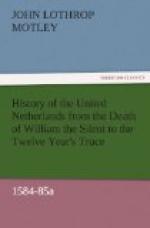“The progress of the League,” said Busbecq, “is teaching the Duc d’ Epergnon manners. ’Tis a youth of such insolence, that without uncovering he would talk with men of royal descent, while they were bareheaded. ’Tis a common jest now that he has found out where his hat is.”
Thus, for a long time, a network of secret political combinations had been stretching itself over Christendom. There were great movements of troops throughout Germany, Switzerland, the Netherlands, slowly concentrating themselves upon France; yet, on the whole, the great mass of the populations, the men and women who were to pay, to fight, to starve, to be trampled upon, to be outraged, to be plundered, to be burned out of houses and home, to bleed, and to die, were merely ignorant, gaping spectators. That there was something very grave in prospect was obvious, but exactly what was impending they knew no more than the generation yet unborn. Very noiselessly had the patient manager who sat in the Escorial been making preparations for that European tragedy in which most of the actors had such fatal parts assigned them, and of which few of the spectators of its opening scenes were doomed to witness the conclusion. A shifting and glancing of lights, a vision of vanishing feet, a trampling and bustling of unseen crowds, movements of concealed machinery, a few incoherent words, much noise and confusion vague and incomprehensible, till at last the tinkling of a small bell, and a glimpse of the modest manager stealing away as the curtain was rising—such was the spectacle presented at Midsummer 1585,
And in truth the opening picture was effective. Sixteen black-robed, long-bearded Netherland envoys stalking away, discomfited and indignant upon one side; Catharine de’ Medici on the other, regarding them with a sneer, painfully contorted into a pathetic smile; Henry the King, robed in a sack of penitence, trembling and hesitating, leaning on the arm of Epergnon, but quailing even under the protection of that mighty swordsman; Mucio, careering, truncheon in hand, in full panoply, upon his war-horse, waving forward a mingled mass of German lanzknechts, Swiss musketeers, and Lorraine pikemen; the redoubtable Don Bernardino de Mendoza, in front, frowning and ferocious, with his drawn sword in his hand; Elizabeth of England, in the back ground, with the white-bearded Burghley and the monastic Walsingham, all surveying the scene with eyes of deepest meaning; and, somewhat aside, but in full view, silent, calm, and imperturbably good-humoured, the bold Bearnese, standing with a mischievous but prophetic smile glittering through his blue eyes and curly beard—thus grouped were the personages of the drama in the introductory scenes.
The course of public events which succeeded the departure of the Netherland deputies is sufficiently well known. The secret negotiations and intrigues, however, by which those external facts were preceded or accompanied rest mainly in dusty archives, and it was therefore necessary to dwell somewhat at length upon them in the preceding pages.




